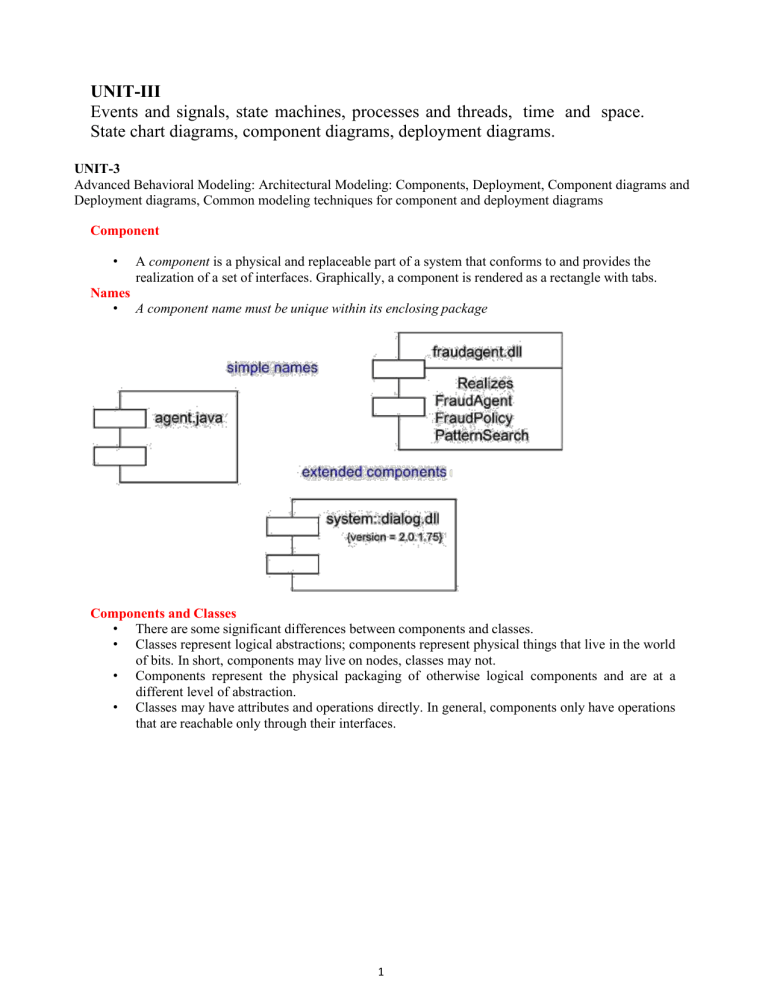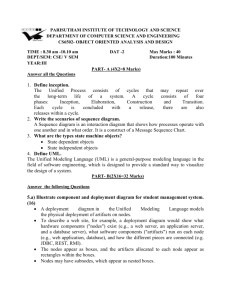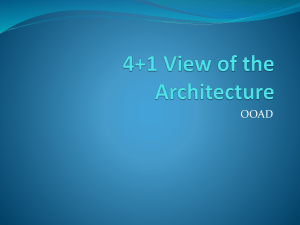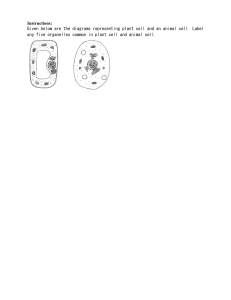
UNIT-III Events and signals, state machines, processes and threads, time and space. State chart diagrams, component diagrams, deployment diagrams. UNIT-3 Advanced Behavioral Modeling: Architectural Modeling: Components, Deployment, Component diagrams and Deployment diagrams, Common modeling techniques for component and deployment diagrams Component • A component is a physical and replaceable part of a system that conforms to and provides the realization of a set of interfaces. Graphically, a component is rendered as a rectangle with tabs. Names • A component name must be unique within its enclosing package Components and Classes • There are some significant differences between components and classes. • Classes represent logical abstractions; components represent physical things that live in the world of bits. In short, components may live on nodes, classes may not. • Components represent the physical packaging of otherwise logical components and are at a different level of abstraction. • Classes may have attributes and operations directly. In general, components only have operations that are reachable only through their interfaces. 1 Components and Interfaces • • • • • An interface is a collection of operations that are used to specify a service of a class or a component. The relationship between component and interface is important. All the most common componentbased operating system facilities (such as COM+, CORBA, and Enterprise Java Beans) use interfaces as the glue that binds components together. An interface that a component realizes is called an export interface, meaning an interface that the component provides as a service to other components. A component may provide many export interfaces. The interface that a component uses is called an import interface, meaning an interface that the component conforms to and so builds on. A component may conform to many import interfaces. A component may both import and export interfaces. Binary Replaceability • • The basic intent of every component-based operating system facility is to permit the assembly of systems from binary replaceable parts. This means that you can create a system out of components and then evolve that system by adding new components and replacing old ones, without rebuilding the system. 2 • • Interfaces are the key to making this happen. When you specify an interface, you can drop into the executable system any component that conforms to or provides that interface. You can extend the system by making the components provide new services through other interfaces, which, in turn, other components can discover and use. These semantics explain the intent behind the definition of components in the UML. Kinds of Components Three kinds of components may be distinguished • First, there are deployment components. • Second, there are work product components. • Third are execution components. Organizing Components • You can organize components by grouping them in packages in the same manner in which you organize classes. • The UML defines five standard stereotypes that apply to components 1. executable 2. library 3. table 4. file 5. document Common Modeling Techniques 1. Modeling Executables and Libraries To model executables and libraries: • • • • Identify the partitioning of your physical system. Consider the impact of technical, configuration management, and reuse issues. Model any executables and libraries as components, using the appropriate standard elements. If your implementation introduces new kinds of components, introduce a new appropriate stereotype. If it's important for you to manage the seams in your system, model the significant interfaces that some components use and others realize. As necessary to communicate your intent, model the relationships among these executables, libraries, and interfaces. Most often, you'll want to model the dependencies among these parts in order to visualize the impact of change. 3 2. Modeling Tables, Files, and Documents To model tables, files, and documents, • • • • Identify the ancillary components that are part of the physical implementation of your system. Model these things as components. If your implementation introduces new kinds of artifacts, introduce a new appropriate stereotype. As necessary to communicate your intent, model the relationships among these ancillary components and the other executables, libraries, and interfaces in your system. Most often, you'll want to model the dependencies among these parts in order to visualize the impact of change. 3. Modeling an API To model an API, • Identify the programmatic seams in your system and model each seam as an interface, collecting the attributes and operations that form this edge. • Expose only those properties of the interface that are important to visualize in the given context; otherwise, hide these properties, keeping them in the interface's specification for reference, as necessary. • Model the realization of each API only insofar as it is important to show the configuration of a specific implementation. 4 4. Modeling Source Code To model source code, • • • Depending on the constraints imposed by your development tools, model the files used to store the details of all your logical elements, along with their compilation dependencies. If it's important for you to bolt these models to your configuration management and version control tools, you'll want to include tagged values, such as version, author, and check in/check out information, for each file that's under configuration management. As far as possible, let your development tools manage the relationships among these files, and use the UML only to visualize and document these relationships. Component Diagrams • A component diagram shows a set of components and their relationships. Graphically, a component diagram is a collection of vertices and arcs. Contents Component diagrams commonly contain • Components • Interfaces • Dependency, generalization, association, and realization relationships Like all other diagrams, component diagrams may contain notes and constraints. Common uses • Component diagrams used to model the static implementation view of a system. • Typically use component diagrams in one of four ways. 1. To model source code 2. To model executable releases 3. To model physical databases 4. To model adaptable systems Common Modeling Techniques 1. Modeling Source Code To model a system's source code: • • Either by forward or reverse engineering, identify the set of source code files of interest and model them as components stereotyped as files. For larger systems, use packages to show groups of source code files. 5 • • Consider exposing a tagged value indicating such information as the version number of the source code file, its author, and the date it was last changed. Use tools to manage the value of this tag. Model the compilation dependencies among these files using dependencies. Again, use tools to help generate and manage these dependencies. 2. Modeling an Executable Release To model an executable release • Identify the set of components you'd like to model. Typically, this will involve some or all the components that live on one node, or the distribution of these sets of components across all the nodes in the system. • Consider the stereotype of each component in this set. For most systems, you'll find a small number of different kinds of components (such as executables, libraries, tables, files, and documents). You can use the UML's extensibility mechanisms to provide visual cues for these stereotypes. • For each component in this set, consider its relationship to its neighbors. Most often, this will involve interfaces that are exported (realized) by certain components and then imported (used) by others. If you want to expose the seams in your system, model these interfaces explicitly. If you want your model at a higher level of abstraction, elide these relationships by showing only dependencies among the components. 3. Modeling a Physical Database To model a physical database: • • • • Identify the classes in your model that represent your logical database schema. Select a strategy for mapping these classes to tables. You will also want to consider the physical distribution of your databases. Your mapping strategy will be affected by the location in which you want your data to live on your deployed system. To visualize, specify, construct, and document your mapping, create a component diagram that contains components stereotyped as tables. Where possible, use tools to help you transform your logical design into a physical design. 6 4. Modeling Adaptable Systems • Consider the physical distribution of the components that may migrate from node to node. You can specify the location of a component instance by marking it with a location tagged value, which you can then render in a component diagram (although, technically speaking, a diagram that contains only instances is an object diagram). • If you want to model the actions that cause a component to migrate, create a corresponding interaction diagram that contains component instances. You can illustrate a change of location by drawing the same instance more than once, but with different values for its location tagged value. 5. Forward and Reverse Engineering To forward engineer a component diagram: • • • For each component, identify the classes or collaborations that the component implements. Choose the target for each component. Your choice is basically between source code (a form that can be manipulated by development tools) or a binary library or executable (a form that can be dropped into a running system). Use tools to forward engineer your models. To reverse engineer a component diagram, • Choose the target you want to reverse engineer. Source code can be reverse engineered to components and then classes. Binary libraries can be reverse engineered to uncover their interfaces. Executables can be reverse engineered the least. • Using a tool, point to the code you'd like to reverse engineer. Use your tool to generate a new model or to modify an existing one that was previously forward engineered. • Using your tool, create a component diagram by querying the model. For example, you might start with one or more components, then expand the diagram by following relationships or 7 neighboring components. Expose or hide the details of the contents of this component diagram as necessary to communicate your intent. Deployment • • • • A node is a physical element that exists at run time and represents a computational resource, generally having at least some memory and, often, processing capability. Graphically, a node is rendered as a cube. Every node must have a name that distinguishes it from other nodes. A name is a textual string. That name alone is known as a simple name; a path name is the node name prefixed by the name of the package in which that node lives. A node is typically drawn showing only its name, as in. Just as with classes, you may draw nodes adorned with tagged values or with additional compartments to expose their details. Nodes and Components There are some significant differences between nodes and components. • Components are things that participate in the execution of a system; nodes are things that execute components. • Components represent the physical packaging of otherwise logical elements; nodes represent the physical deployment of components. 8 Connections • The most common kind of relationship you'll use among nodes is an association. In this context, an association represents a physical connection among nodes, such as an Ethernet connection, a serial line, or a shared bus, as Figure . Common Modeling Techniques 1. Modeling Processors and Devices To model processors and devices: • • • Identify the computational elements of your system's deployment view and model each as a node. If these elements represent generic processors and devices, then stereotype them as such. If they are kinds of processors and devices that are part of the vocabulary of your domain, then specify an appropriate stereotype with an icon for each. As with class modeling, consider the attributes and operations that might apply to each node. 2. Modeling the Distribution of Components To model the distribution of components: • For each significant component in your system, allocate it to a given node. 9 • • • • • Consider duplicate locations for components. It's not uncommon for the same kind of component (such as specific executables and libraries) to reside on multiple nodes simultaneously. Render this allocation in one of three ways. Don't make the allocation visible, but leave it as part of the backplane of your model• that is, in each node's specification. Using dependency relationships, connect each node with the components it deploys. List the components deployed on a node in an additional compartment. Deployment Diagrams A deployment is a diagram that shows the configuration of run time processing nodes and the components that live on them. Graphically, a deployment diagram is a collection of vertices and arcs. Contents Deployment diagrams commonly contain • Nodes • Dependency and association relationships Like all other diagrams, deployment diagrams may contain notes and constraints Common Uses When you model the static deployment view of a system, you'll typically use deployment diagrams in one of three ways. 1. To model embedded systems 2. To model client/server systems 3. To model fully distributed systems Common Modeling Techniques 1. Modeling an Embedded System To model an embedded system: • Identify the devices and nodes that are unique to your system. • Provide visual cues, especially for unusual devices, by using the UML's extensibility mechanisms to define system-specific stereotypes with appropriate icons. At the very least, you'll want to distinguish processors (which contain software components) and devices (which, at that level of abstraction, don't directly contain software). • Model the relationships among these processors and devices in a deployment diagram. Similarly, specify the relationship between the components in your system's implementation view and the nodes in your system's deployment view. • As necessary, expand on any intelligent devices by modeling their structure with a more detailed deployment diagram 10 2. Modeling a Client/Server System To model a client/server system: • • • • Identify the nodes that represent your system's client and server processors. Highlight those devices that are germane to the behavior of your system. For example, you'll want to model special devices, such as credit card readers, badge readers, and display devices other than monitors, because their placement in the system's hardware topology are likely to be architecturally significant. Provide visual cues for these processors and devices via stereotyping. Model the topology of these nodes in a deployment diagram. Similarly, specify the relationship between the components in your system's implementation view and the nodes in your system's deployment view. 3. Modeling a Fully Distributed System To model a fully distributed system: • Identify the system's devices and processors as for simpler client/server systems. 11 • • • • If you need to reason about the performance of the system's network or the impact of changes to the network, be sure to model these communication devices to the level of detail sufficient to make these assessments. Pay close attention to logical groupings of nodes, which you can specify by using packages. Model these devices and processors using deployment diagrams. Where possible, use tools that discover the topology of your system by walking your system's network. If you need to focus on the dynamics of your system, introduce use case diagrams to specify the kinds of behavior you are interested in, and expand on these use cases with interaction diagrams. 4. Forward and Reverse Engineering To reverse engineer a deployment diagram: • • • • • Choose the target that you want to reverse engineer. In some cases, you'll want to sweep across your entire network; in others, you can limit your search. Choose also the fidelity of your reverse engineering. In some cases, it's sufficient to reverse engineer just to the level of all the system's processors; in others, you'll want to reverse engineer the system's networking peripherals, as well. Use a tool that walks across your system, discovering its hardware topology. Record that topology in a deployment model. Along the way, you can use similar tools to discover the components that live on each node, which you can also record in a deployment model. You'll want to use an intelligent search, for even a basic personal computer can contain gigabytes of components, many of which may not be relevant to your system. Using your modeling tools, create a deployment diagram by querying the model. For example, you might start with visualizing the basic client/server topology, then expand on the diagram by populating certain nodes with components of interest that live on them. Expose or hide the details of the contents of this deployment diagram as necessary to communicate your intent. 12



